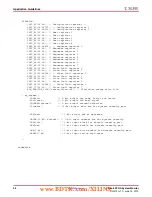
Virtex-6 FPGA System Monitor
39
UG370 (v1.1) June 14, 2010
Analog Inputs
Analog Inputs
The analog inputs of the ADC use a differential sampling scheme to reduce the effects of
common-mode noise signals. This common-mode rejection improves the ADC
performance in noisy digital environments.
shows the benefits of a differential
sampling scheme. Common ground impedances (R
G
) easily couple noise voltages
(switching digital currents) into other parts of a system. These noise signals can be 100 mV
or more. For the System Monitor ADC, this noise voltage is equivalent to 100 LSBs, thus
inducing large measurement errors. The differential sampling scheme samples both the
signal and any common mode noise voltages at both analog inputs (V
P
and V
N
). The
common mode signal is effectively subtracted because the Track-and-Hold amplifier
captures the difference between V
P
and V
N
, such as, V
P
– V
N
(see
Table 19:
Timing Event Information
Event
Description
t
1
DCLK period
(1)
t
2
Minimum DEN setup time before the rising edge of DCLK
(2)
t
3
Minimum DEN hold time after the falling edge of DCLK
t
4
Minimum DWE setup time before the rising edge of DCLK
(3)
t
5
Minimum DWE hold time after the falling edge of DCLK
(3)
t
6
Minimum DRP address set up time before rising edge of DCLK
t
7
Minimum DRP address hold time after rising edge of DCLK
t
8
Minimum DRP input data bus set up time before rising edge of DCLK
t
9
Minimum DRP input data bus hold time after rising edge of DCLK
t
10
Maximum DRP DCLK to DO delay/access time
(4)
t
11
Maximum delay on DRDY going High/Low after a rising edge on DCLK
t
12
Maximum delay on EOC/EOS going High/Low after a rising edge on DCLK
t
13
Maximum delay on ALM[2:0]/OT going High after a rising edge on DCLK
t
14
Maximum delay on BUSY going High/Low after a rising edge on DCLK
t
15
Maximum delay on CHANNEL[4:0] on rising edge of DCLK
Notes:
1. Minimum DCLK duty cycle is 60/40.
2. DEN should
only
be pulsed for one DCLK cycle.
3. For a DRP write operation, address on DADDR[6:0] and DI[15:0] are latched on the rising edge of DCLK when DEN and WEN are
High. The data is in placed in the DRP register three DCLK cycles later. DRDY goes High when the data has been written. See the
Dynamic Reconfiguration Port description in the
Virtex-6 FPGA Configuration Guide
for more information.
4. For a DRP read operation, address on DADDR[6:0] is latched on the rising edge of DCLK when DEN is High, and three DCLK cycles
later the data is placed on the DO bus. DRDY goes High when the data on DO is valid. See the Dynamic Reconfiguration Port
description in the
Virtex-6 FPGA Configuration Guide
for more information.
www.BDTIC.com/XILINX
















































